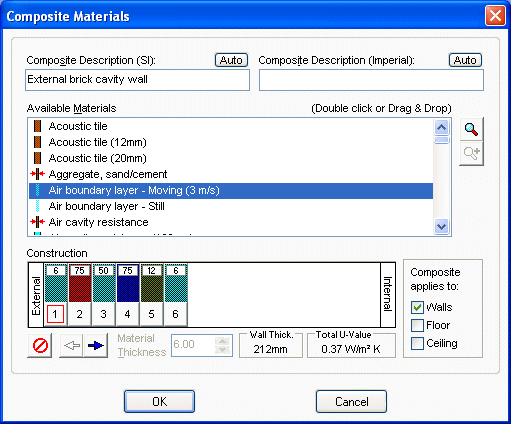(not applicable to Coldwind)

Air boundary layer is used to describe the phenomenon that materials 'entrain' a shallow region of air close to their surfaces. Although on exposed construction materials, prevailing winds will disturb this layer it is nonetheless important to consider its beneficial insulating effects, particularly when materials with intrinsically high heat transfer coefficients (poor thermal insulators) are under consideration. That it always occurs is a certainty, it is however often ignored because it has little effect when included in calculations involving well insulated composite material walls and because of the extra work involved in manual calculations. Mistral's database of composite materials always includes air boundary layers - with 3 metres (approximately 10 ft) per second wind velocity in the case of outside exposed surfaces and 'still' air in the case of interior surfaces.
The thickness of the air boundary layer is assumed to be 6mm (¼") for most practical purposes (it is anyway not possible to attribute a precise dimension as the limit of the air layer region is indefinite. The thickness of the air boundary layer will in practice also vary depending upon surface roughness factors but 6mm (¼") represents a reliable mean value for calculation purposes). When selecting air boundary layers it is of course not possible to have two or more layers adjacent to each other and the program is error trapped to prohibit this.
See also:-
databases
databases editing (materials)
Notes:-
When to include the Air Boundary Layer component in a load calculation.
Debates have raged over many years about whether Air Boundary Layer should be included in calculating the movement of energy (the K factor) through a material. The simple answer is that most documented data for K factors was empirically based and often included the effect of Air Boundary Layer whether it was intended or not. The fact is that Air Boundary Layer does exist and it can have a significant effect in a calculation. Much empirically based K factor data therefore is actually incorrect as it is actually a figure based upon the heat transfer coefficient through the material to be measured along with the effect of Air Boundary Layer on one or both sides exposed to atmosphere. Thus, adding Air Boundary Layer again in such cases would clearly be incorrect. Mistral invested in considerable research to establish factually K factor data for inclusion in program databases.
How then to know whether to include Air Boundary Layer or not? The refrigeration industry has traditionally used only single component U values (K factor/thickness of material) for load calculation purposes, using U values which were empirically based. Where, as is normal in refrigeration applications, wall and ceiling construction materials are described as ‘insulating’, due to their properties of offering relatively high resistance to heat energy transfer, application of Air Boundary Layer has been ignored for the most part. Indeed the Air Boundary Layer component, although hidden, was habitually already included anyway.
With materials where heat transfer rates are relatively high, with heavy construction materials such as dense brick or concrete then Air Boundary Layer makes a significant difference. However Air Boundary Layer should naturally only be included in overall U value computation for a laminate of two or more materials on the outside surfaces that are exposed to air. A mathematical process that Mistral’s air conditioning program Airwind handles automatically. Adding or including Air Boundary Layer automatically as necessary.
In Mistral’s refrigeration program Coldwind the Air Boundary Layer component, as it has already been included in the overall U value of the commonly used insulating materials generally used throughout, was deemed to be unnecessary. Doing so would also anyway have resulted in a minor distortion of load calculation results when compared to calculation results from traditional and accepted manual calculation methods.
A problem only arises in applications where refrigeration calculations are performed where design conditions approach those used in typical air conditioning cases and where non insulating materials are used in the refrigeration design. For some Food Preparation Rooms for example and where not all wall surfaces are insulated to the same standard as a typical cold room. In which case it becomes prudent for the engineer to select and add Air Boundary Layer to room construction materials that have been selected from databases normally reserved for air conditioning applications. Although in cases involving only a relatively small amount of surface areas with poor insulation qualities the absence of Air Boundary Layer is unlikely to make a huge difference to a calculation result.